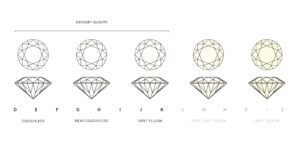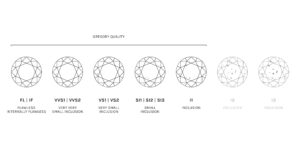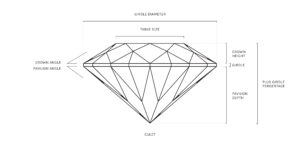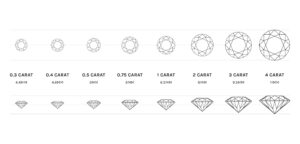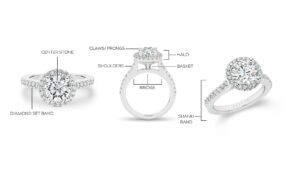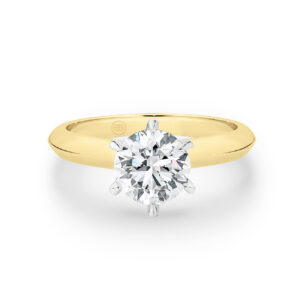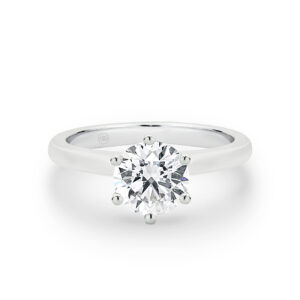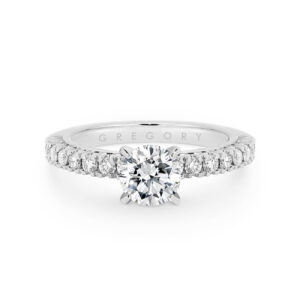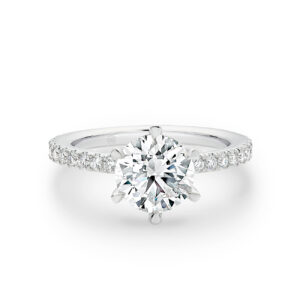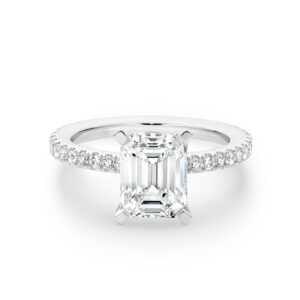
- Introduction
- Establishing a Budget
- Diamond Fundamentals
- The Buying Process
- Selecting a Stone
- Choosing a Gemstone Shape
- How to Choose the Right Gemstone Shape for Your Ring
- Selecting a Ring Style and Setting
- Popular Engagement Ring Settings
- Choosing a Metal
- Custom Engagement Rings
- Finding a Trusted Jeweller
- Engagement Buying FAQ
Congratulations on embarking on this exciting journey. An engagement ring is an unmistakable symbol of love and devotion given to your partner as a timeless reminder of your commitment to one another. Here at Gregory Jewellers, we understand the significance of this romantic purchase and that it requires careful thought, serious consideration, and a deep understanding of your partner and your relationship.
With over fifty-five years’ experience creating the finest Australian-made jewellery, we have curated this comprehensive guide to help you navigate through each element of the buying process to ensure you can select the perfect engagement ring.
At Gregory Jewellers we firmly believe that a ring’s worth is not dictated by the cost, but the meaning behind it. Although, budget does play an important role in in the selection process.
We recommended entering the buying process with a figure in mind. Giving this snippet of information to a jeweller will make the buying process infinitely easier, as you will only be shown diamonds and rings that are affordable to you, narrowing the spectrum of seemingly overwhelming possibilities.
Irrespective of budget, understanding the 4Cs as discussed above will ensure you are well equipped to compare diamond options. To find the perfect diamond for you, we recommend selecting a diamond shape and then finding a balance between size and quality. Depending on the importance of each characteristic to your personal circumstances, you may choose to forgo diamond carat in return for a more flawless or colourless stone. One area not to compromise is on diamond cut, ensuring your diamond exhibits excellent proportion and brilliance.
Gregory Jewellers offers a variety of flexible payment options, including ZIP, Afterpay and HUMM.
Protecting your Investment
Regardless of cost, every engagement ring is priceless when it comes to sentimental value. Due to the significance of this piece, Gregory Jewellers recommends insuring with a trusted jewellery insurance specialist so that you can wear your jewellery with confidence every day.
Our partners, Centrestone Jewellery Insurance, have the most comprehensive policy on the market to give you absolute peace of mind when it comes to your treasured jewellery. Centrestone Jewellery Insurance policies can be specifically tailored to you, ensuring the unique protection needed for your engagement ring.
One of the first, and perhaps most important, pieces of knowledge to possess before beginning the search for the perfect engagement ring is the fundamentals of diamonds. The quality and aesthetic of centre stone, most often a diamond, will define your engagement ring. Here we outline the basic knowledge you need to shop for diamonds with confidence.
Diamonds are assessed on a universal standard known as the 4Cs. These four physical characteristics are Colour, Clarity, Cut and Carat and allow both jewellers and clients to objectively compare and value diamonds. For Gregory Jewellers, we use a meticulous process of individually selecting each diamond by eye to ensure we acquire the most beautiful diamonds as defined by the 4Cs.
Colour
The colour of a diamond is an important characteristic for determining a diamond’s value. Diamonds are normally characterised by their lack of colour and using a set of authenticated master diamonds to compare against, each diamond is given a grade using the English alphabet from D (colourless) to Z (most saturated colour). Put simply, the less colour, the higher the value. The exception to this is fancy-colour diamonds, such as pinks and blues, which lie outside this colour scale.
Many consider high-quality diamonds as colourless, however truly colourless diamonds are very rare. In well-cut diamonds, many of these colour differences are invisible to the untrained eye but influence the value of a diamond significantly.
The colour of your ring metal will also impact the colour appearance of the stone, as the diamond reflects the ring band. White gold settings act like a mirror and can make a diamond appear whiter than it is.
GJ Expert Tip – For a more accurate insight into the true colour of a diamond, you should ask your jeweller to see the diamond, or one of a comparative grades, loose before it is set.
Clarity
As diamonds are formed under extreme heat and pressure deep within the earth, they often contain internal inclusions or blemishes. Clarity refers to the purity of a diamond. Diamonds with very few or without these inclusions or blemishes are very rare, and therefore also highly valued. These diamonds have a high clarity grade.
Low clarity diamonds have larger, opaque inclusions that can interfere with the diamond’s brilliance and can be visible to the human eye. The Gregory standard ensures that each diamond’s clarity is assessed by our team of diamond buyers before it is purchased. This meticulous process of selecting each diamond by eye refines each clarity grade, allowing us the opportunity to source the best each grade has to offer.
GJ Expert Tip – Most inclusions and blemishes are only visible to a trained jeweller using 10x magnification. Discuss clarity with your jeweller in terms of how it will affect a stone’s brilliance or the way it interacts with light.
Cut
A common misconception is that ‘diamond cut’ refers only to a diamond’s shape. However, the precision of cut and overall proportion of a diamond when being cut from a rough diamond, ultimately determines the brilliance of the diamond.
A polished diamond’s brilliance lies in its complex relationship with light – how light reflects off the facets, how much light enters the diamond, and the amount of light returns to the eye. The proportion of each individual diamond directly affects its brilliance and appeal. Diamonds with excellent proportions, symmetry and polish optimise their interaction with light.
GJ Expert Tip – Diamonds are often cut to retain weight rather than excellent proportion, as this may sometimes yield a slightly higher price, but comes at the expense of overall quality. Ensure you speak to your jeweller about diamond cut, as the more precise the cut, the better brilliance, fire, and scintillation your diamond will show.
Carat
Carat is one of the most well-known terms used to measure a diamond and simply refers to the weight of a diamond. A carat is equal to 200 milligrams in weight, with each carat divided into 100 points to provide an extremely accurate measurement of weight.
GJ Expert Tip – It is important to remember that carat weight alone does not determine a diamond’s value. Diamonds of equal weight can vary widely in price because of difference in other characteristics. In the same vein, a bigger diamond isn’t always best. Smaller stones that possess more desirable diamond characteristics can be more expensive than larger carat stones.
The Gregory Standard ensures that our diamonds are carefully examined by eye and considered beyond certified characteristics alone, this includes important considerations such as lustre and overtone.
In this section we delve into the many intricacies of the buying process. From selecting the perfect stone for your partner’s style and preference to the various traditional and modern gemstone shapes and how this culminates into final, beautiful setting. These exciting selections not only determine an engagement rings overall appearance, but also its distinctiveness and reflection of your own unique love story.
White Diamonds
The traditional diamond is the most iconic choice for engagement rings. With a sentiment that ‘diamond’s last forever’, there is no disputing an exquisite diamond ring is a signal of everlasting love.
White diamonds are renowned for their classic elegance and beauty. They possess a sparkle that adds luxury to everyday wear, with a colourless appearance makes them a versatile choice, suiting all styles and skin tones. Diamonds also provide the benefit of unmatched durability, making them ideal for everyday wear.
The timeless solitaire is one of the most popular choices for white diamond engagement rings. At Gregory Jewellers we have a wide variety of white diamond engagement ring options available to suit a spectrum of budgets.
Fancy Coloured Diamonds
If you love the timelessness of a traditional diamond, but are looking for a modern and unique alternative, fancy coloured diamonds may be the perfect fit for you and your partner.
Part of the allure of a coloured diamond comes from an array of rare and beautiful colours.
Diamonds in stunning hues of yellow and pink combine luxury and individuality into a truly unique style statement. In contrast to white diamonds, fancy coloured diamonds are graded and priced on the intensity of their colour, adding to their extreme rarity and value.
Coloured Gemstones
Beautiful coloured gemstones are another increasingly popular alternative to the traditional diamond engagement ring. Gemstone engagement rings channel the uniqueness of a coloured diamond whilst remaining more cost-effective for many budget-conscious couples. Some of the popular alternative gemstones include rubies, sapphires, morganites, and emeralds.
A coloured gemstone also offers a unique opportunity to personalise an engagement ring, particularly if the gemstone holds special meaning to the wearer such as a birthstone.
When selecting a gemstone for an engagement ring it is important to note that their innate characteristics differ from the traditional diamond and as such may not be suitable for all. At Gregory Jewellers we work with a variety of gemstones and deeply understand the unique characteristics of each and can help you select a gemstone that will perfectly align to your lifestyle.
Coloured Gemstones
Ruby
With a rich and brilliant red hue, ruby engagement rings are the perfect symbol of love and passion. Rubies retain a high value and are an extremely sought after coloured gemstone due to their superior durability and stunning romantic colouring.
Sapphire
Known for their iconic royal blue shade, many are surprised to learn these exquisite and durable gemstones occur in a rainbow-range of colours. Sapphire engagement rings represent loyalty, trust, and truth making them a beautiful choice to express your eternal love.
Morganite
Embodying romance and femininity, morganite is perhaps one of the most popular choices for contemporary engagement rings. For many, Morganite is a beautiful and affordable alternative to the stunning pink diamond, with its relative durability making it suitable for everyday wear.
Tanzanite
Tanzanite is known for its rarity, unique sparkle, and radiant blue-violet hue. With an unmatched uniqueness, Tanzanite engagement rings symbolise prosperity, good fortune, and optimism for a future of eternal happiness. Whilst this stone is less durable than other gemstone options on the market, its exclusivity and affordable price point makes it a worthwhile investment for an engagement ring.
A gemstone’s shape, sometimes referred to as its cut, is a defining feature of any engagement ring. Shape is essentially the overall geometry or form of the gemstone. Each shape is cut to different specifications, meaning light reflects differently to present a distinctive brilliance that impacts the overall appearance of your engagement ring.
Gemstone shape is an important consideration in any engagement ring purchase. Shape not only influence diamond appearance, but price, brilliance, and fragility. This is what makes knowledge of this essential factor, crucial to any buyer to be.
Our comprehensive overview provides an insight into the different gemstone shapes and the key features of each so you can confidently move through the process of selecting the perfect engagement ring.
Round brilliant is undeniably the most popular gemstone shape, setting the standard for brilliance and beauty this shape makes up an estimated 70 per cent of all diamonds sold today. Their attractiveness lies in their symmetrical shape, everlasting character, and their excellent dispersion of light achieved through a faceting pattern that is optimised for sparkle.
Often highlighted in solitaire engagement rings, this shape has won the hearts of brides-to-be across the world for generations. Despite their premium price tag, this shape is ideal for those seeking an exceptionally radiant, timeless diamond.
The oval cut is a modern variation of the round brilliant cut, possessing similar fire and brilliance its 58 facets are stretched into a symmetrical oval silhouette. The elongation of the cut maximises the look of the diamond’s carat weight giving the illusion of a larger diamond and elongated fingers for the wearer. Even with their similarity to round cut diamonds, ovals are less popular, making them more affordable choice for a classic engagement ring.
A pears unique teardrop shape is a hybrid of the modern round brilliant and the marquise cuts. With 58 facets, this shape has similar brilliance to round cut but with a distinct asymmetrical shape. The elongated design of the pear shape makes it one of the most pleasing diamond cuts, making it popular among modern brides who appreciate its flattering shape and astounding sparkle. Pear shapes are most commonly paired with halo settings to accentuate their unique dimensions.
Inspired by the early style of French cut diamonds, the contemporary princess cut is a popular diamond shape for engagement rings. Of all the square diamond shapes, the princess cut is most brilliant, with the modern mixed-cut design fusing both brilliant and step cuts to provide an unmatched sense of depth and sparkle. These features add to the princess cut’s unique yet simple beautiful appearance that looks incredible in almost any ring setting.
Steeped in history, the cushion shape is of the oldest fancy diamond cuts available, with its facets arranged to sparkle in the dim, candlelight of centuries past. Today, cushion cuts merge this antique style with the modern ovals for a fresh take on a vintage look. With either square or rectangular silhouettes, these pillow-shaped diamonds have broad facets and rounded corners that emit broad pops of light, rather than the intense sparkle exhibited by modern brilliant diamonds.
Blending the silhouette of an emerald cut diamond with the brilliance of a modern round, the faceting pattern and deep profile of a radiant cut provides incredible scintillation in an engagement ring. The distinctive trimmed corners of this cut also enhance its durability. An elongated radiant cut diamond is an excellent option for those who like shape of an emerald cut but seek the brilliance of a round diamond.
An emerald cut flaunts an elongated, rectangular shape with chiselled step cuts, straight linear facets, and cropped corners to improve gemstone stability. Its striking appearance and satisfying symmetry embody a vintage art deco style, making emerald cuts the perfect pairing to solitaire and simple pavé engagement ring settings.
With a distinct art deco styling, the striking symmetry, and bold lines of the asscher cut soared in popularity during the 1920s. The asscher shape possesses trademark high crowns, small tables, and step-cut pavilions similar to an emerald cut, resulting in an excellent dispersion of light and a unique geometric sparkle.
The marquise is another brilliant cut gem with 58 sparkling facets that come to a dramatic point at each end, ensuring exquisite brilliance as each of the facets captures and reflects light beautifully. With the largest surface area of any diamond, the marquise maximizes the look of its carat weight with this stretched out shape. The elongated shape of the marquise is extremely flattering making the fingers appear long and slender.
As the main focal point of an engagement ring, selecting the right gemstone shape can be a daunting undertaking. However, it is often worthwhile asking yourself these two questions if you’re struggling to decide on style.
Is my partner’s style classic?
If your partner’s style embodies simple elegance, you may like to choose a classic diamond shape such as the round brilliant, oval or cushion cut to emphasise the beauty of the stone. Vintage, art deco inspired cuts such as the emerald and Asscher cut are also a popular choice for classic brides-to-be.
Is my partner’s style modern?
If so, your partner may prefer a less traditional cut and setting. You may choose a more modern shape such as the princess, pear, or marquise cuts. Modern settings can complement these cuts, with coloured gemstones another popular choice for contemporary brides seeking to make a unique and personal engagement ring statement.
Selecting a Ring Style and Setting
Deciding on ring style and setting is one of the most important choices you’ll make when selecting an engagement ring. Not only is it a representation your partner’s personal style, but an important factor in enhancing the look of your preferred gemstone.
When searching for the perfect ring setting, consider what fits your partner’s lifestyle and personality best. In addition to your budget, personal style and daily activities form important considerations that should guide setting selection.
This section provides an overview of the most popular engagement ring settings and the key considerations to keep in mind for each, including functionality and wearability.
The Anatomy of an Engagement Ring Setting
First and foremost, it is helpful to understand the many engagement ring elements you may hear jewellers refer to when discussing ring setting and style. This is what we refer to as the anatomy of an engagement ring.
Once you understand the anatomy of an engagement ring, it is easier to recognise the distinct features that define an engagement ring setting. We have profiled a selection of the most iconic engagement ring styles, highlighting how they fuse beautiful design, diamonds, and craftsmanship.
Solitaire
A solitaire engagement ring setting is by far the most popular. This traditional setting channels classic elegance and features a metal claw that grips a single diamond ‘solitaire’ tightly to highlight its magnificence.
The key benefit of this setting is that it elevates the diamond to increase its prominence and there is a minimum presence of metal, thus showcasing more of the diamond and allowing lighter to pass through the diamond to enhance its overall brilliance. As the ultimate statement of elegance and tradition, this engagement ring setting will also never go out of style.
If considering a solitaire setting it is important to keep in mind that the claws can often snag on clothing or other items and the claw may loosen over time. We suggest opting for a lower set claw if you have a particularly active lifestyle and having your ring inspected by a jeweller every two years to ensure the stone remains secure.
Diamond Set Band or Pavé
A diamond set band engagement ring setting is also commonly referred to as a pavé setting. Pronounced ‘pa-vay’, this term comes from the French for ‘to pave’, and quite literally refers to an engagement ring setting that has been paved with diamonds. This setting features small diamonds placed tightly together with minimal visibility of the metal band and prongs holding the stones in place with the effect one of high scintillation.
Diamond set bands highlight the beauty of a centre stone whilst adding to the ring’s overall brilliance with additional diamonds. The continuous scintillation exhibited by this setting also gives the illusion that the diamonds are more plentiful and larger than they are, making this style relatively budget friendly.
Engagement rings featuring a diamond set band are traditionally more difficult to resize, therefore it is important to have an accurate ring size if considering this setting. Due to its inclusion of small diamonds this setting is also less durable and is harder to clean than other popular settings.
Halo
Halo engagement ring setting features a scintillating ‘halo’ of brilliant diamonds around a striking centre stone with light gathered and mirrored throughout the design, resulting in an unrivalled display of brilliance. These popular settings are extraordinarily beautiful and another fantastic way to maximise your budget, with the halo adding sparkle and making the centre diamond seem larger.
Selecting a halo setting is a fantastic way to save money by using a smaller-carat diamond without sacrificing the overall appearance or size of the ring. The setting also protects the centre stone, making it an excellent choice for those who require a relatively enduring engagement ring style.
Similar to the diamond set band, this style can be difficult to resize, and small diamonds can become loose over time.
Trilogy
Often referred to as a trinity or three stone engagement ring, a trilogy engagement ring setting features three gemstones or diamonds – traditionally seen to symbolise a couples past, present and future. This setting is a versatile style that most frequently sees a larger centre stone, paired with slightly smaller stones flanking each side.
This setting exhibits excellent brilliance and can enhance the appearance of centre stone when paired properly with side stones. The two extra adjacent stones within this setting allow for creativity and personalisation, with sapphires, rubies and emeralds making for beautiful contrast when worn. A three stone style works best with symmetrical shapes like round or princess cut diamonds.
With a trilogy setting it is important to consider that the use of side stones may detract from the size and appearance of the centre stone. Given the size of the side stones, diamond colour and clarity are an important consideration of this setting.
Cluster
In a cluster engagement ring setting, smaller diamonds are set closely together to give the overall illusion of a larger diamond. A cluster setting can contain either a large centre stone surrounded by smaller diamonds, or feature a group of stones of equal size. The diamonds within in a cluster setting can form a geometric shape, such a square, or a unique design like a flower or starburst which can give the cluster setting a distinct antique look.
The additional character and style exhibited by a cluster setting makes it a popular choice for the unique yet classic bride. Its use of smaller stones is often more budget-friendly than purchasing one large diamond and its style compliments smaller hands and fingers.
Bezel
The bezel ring setting offers a modern look and is suitable for an active lifestyle. Unlike other settings that hold the centre diamond with claws, a bezel setting encircles the diamond with a thin metal rim. This ensures the stone is held tightly in place and makes the setting one of the most durable of the engagement ring styles.
A bezel setting also provides easy maintenance for the wearer and protects the gemstone from potential damage, however this comes at the cost of diamond brilliance as more of the stone is hidden within a bezel setting.
Questions For Your Jeweller When Choosing a Ring Setting
As with many engagement ring design decisions, there are certain considerations that should factor into your stone setting selection. Be sure to ask your jeweller how each setting rates in terms of:
- Wearer lifestyle. Will this ring fit with my partner’s lifestyle? Does it include securely set diamonds that can help prevent from damage or loss?
- Cleaning. Whilst intricate settings are beautiful, will this ring be difficult to clean and maintain?
- Replacement. How easy is it to resize and replace this setting?
- Does this setting help prevent damage to the centre stone?
- Is this setting prone to snagging on clothes?
Once you’ve selected the perfect gemstone and complimentary ring setting, the final consideration comes down to choosing a precious metal. Finding the right metal for an engagement ring is just as important as the diamond or gemstone it will hold, as each metal has advantages for looks, sturdiness and cost.
With a variety of different metals to choose from, it is important to consider several characteristics to help decide which metal is the best option for your special someone. The following covers the most popular precious metals for engagement rings and the key features of each to help guide your decision making.
Platinum
Platinum is one of the most popular metals for engagement rings due to its superior strength and durability and beautiful white hue. At Gregory Jewellers, Platinum 950 is recommended. It is an ideal choice for those who work with their hands every day and seek a sturdy metal. Over time, platinum may wear and scratch with use, but can be polished by a jeweller to return it to pristine condition.
Key Benefits
- Strength and durability
- A beautiful silvery white lustre
- Requires little maintenance, does not tarnish or oxidise
- Extremely dense, less malleable than gold
- Hypoallergenic metal
Gold
Traditionally considered the standard for engagement and wedding jewellery, Gold is prized for its incredible beauty and versatility. The standard measurement of gold is a karat, which is divided into 24 parts. Gold is 24 karats, meaning 24 out of 24 parts are gold. However, fine gold is too malleable to be used for jewellery, so it’s combined with other metal alloys to lend strength and durability to this beautiful metal. Gregory Jewellers utlise only 18K gold in our engagement rings providing the advantage of purity, which is important when you are creating a ring for a lifetime. An 18K gold percentage is also less likely to trigger any skin conditions or allergic reactions as the presence of other metals and alloys is minimal.
Gold metals are typically the following colours:
Yellow Gold
With a naturally warm, yellow hue and beautiful lustre, yellow gold mixes alloys of silver and copper to create a metal that is both romantic and timeless. Whilst not as durable as platinum, it is still suited for everyday wear and its rich yellow gold colouring will remain true over time.
Key Benefits
- Classic, timeless choice
- Beautiful lustre with hues that compliment warm skin tones
- Suitable durability for everyday wear
White Gold
More contemporary than yellow gold, white gold achieves its silvery white hue from mixing materials such as silver and palladium. White gold engagement rings are plated with a hard element called rhodium to resist scratches and tarnishing and gives white gold a reflective appearance.
Gregory Jewellers uses a palladium, rich quality white gold which is superior to many other comparative metals on the engagement ring market. This combination of materials ensures the metal possesses an appealing white lustre even without rhodium plating.
Key Benefits
- Beautiful lustre with hues that compliment cool skin tones
- Popular choice, meaning a wide range of engagement rings feature this metal
- Rhodium plating increases durability, however, does require maintenance (replating)
Rose Gold
Rose gold’s lustrous blush-pink tone is an increasingly popular choice for unique and romantic bride-to-be. Combining gold and copper to create this beautiful hue, rose gold also represents a durable choice for an engagement ring that does not require the same maintenance as other gold equivalents.
Key Benefits
- A unique alternative to traditional metals
- Does not require rhodium plating
With most engagement rings, any setting can be paired with any band and any diamond. We like to think the process of creating a custom engagement ring allows couples to truly encapsulate their love story within a one-of-a-kind, tailored piece.
Sharing an insight into your partner’s personality traits can help us guide you towards which engagement ring will be best for you.
Creating a custom piece doesn’t mean starting from a blank canvas. You can bring your own inspiration or select an existing ring and have specific elements changed to you or your partner’s liking. Typically, the process of creating a custom ring takes around four weeks to produce (and an additional week to develop the design), so take this into account when deciding where and when you’re going to pop the question.
When designing a custom ring with Gregory Jewellers, we welcome you and your partner instore to create a wax model of your hand to illustrate what the ring will look like. Gregory Jewellers can also develop unique ring designs using CAD software before printing them in 3D. This allows you and your partner to see how the dimensions appear on the hand before the actual ring is made.
Whilst you may feel overwhelmed by entering the buying process alone, we continue to see more and more couples going instore to make this important decision together. Why not make this a truly personal experience by taking your partner instore to create their perfect custom engagement ring?
The prospective purchase of an engagement ring can be overwhelming. However, having a trusted jeweller supporting and guiding you can help to ensure a smooth buying journey and the selection of the perfect engagement ring. You’ll also always have someone to turn to when your engagement ring needs care in the future.
Whilst there are endless opportunities to browse and purchase engagement rings online, it is important to remember that it is virtually impossible to make an informed judgment by simply viewing pictures on a screen. Particularly with such a significant purchase, it is important to compare the real-life brilliance and lustre of an engagement ring in addition to having face-to-face conversation with a trusted jeweller.
As you begin your engagement purchase journey consider the following about your jeweller:
- Does the jeweller hold a strong reputation? Selecting a reputable jeweller ensures you have experience guiding your purchase. Start with exploring client reviews and testimonials to check the legitimacy and reputation of any potential jewellers or boutiques.
- Will the jeweller take the time to discuss the finer elements with you? A jeweller or jewellery specialist should take the time to provide a detailed explanation of the pieces offered and provide transparency around the specifications of the ring. A great jeweller understands the uniqueness of each customers desires and needs. They are there to guide customers to their perfect piece
- Is the jeweller credible and established within the industry? Legitimacy is an important when choosing such an important investment. Gregory jewellers is founded on generations of jewellery making, giving you the peace of mind when purchasing. Jeweller prominence also ensures you will have the ability to return in the future for anniversary gifts, ring resizing, cleanings and repairs.
- Does the jeweller offer a large enough selection and apply quality controls, including scanning for synthetic (CVC) diamonds? A wide selection of styles, pieces, and designs gives endless opportunity and ensures you can find the ideal engagement ring for your partner. A trusted jeweller will also apply the most stringent quality controls to ensure the highest standards for product quality are maintained.
- What is the jeweller’s certification and appraisal policy? A jeweller should always be upfront and able to provide authentication details for diamonds. Ask them to provide the certificate and to assist in reading its details. Do not trust a jeweller who asks you to take their work on diamond quality without a certification. It is important to note that some smaller diamonds used in Gregory Jewellers’ designs are not certified but a valuation will be provided, this is a standard across the jewellery industry.
- Does the jeweller offer insurance? A trusted jeweller will explain the benefits of jewellery insurance at the time of purchase and ensure jewellery is covered from the moment you leave the boutique.
Should l Match the Wedding Band to the Engagement Ring?
Yes, absolutely. These pieces are intended to be worn together and as such they should fit seamlessly and add to each other’s brilliance and beauty. We highly suggest asking your jeweller about wedding bands when purchasing an engagement ring. Bridal sets are very common and ensure both engagement and wedding rings are the perfect match. If you are unsure of what wedding band your partner will like, try opting for a higher engagement ring setting to ensure enough space underneath for their desired wedding band or an engagement ring setting with a bridge.
Are Small Differences in Carat Size Really Noticeable?
This relatively subjective and depends on the individual. Generally, differences in carat size are less noticeable in smaller diamonds (0.40 to 0.50 carats) than larger sized diamonds (1.70 to 2.00 carats). If you are concerned about choosing a smaller carat diamond, consider selecting a diamond shape and setting that gives the illusion of a bigger diamond.
How Much Do Engagement Rings Cost?
Engagement rings vary greatly in price, which makes having a budget before entering the buying process paramount. The price of your engagement ring will depend on the design, choice of metal, and your choice of diamond or coloured gemstone. Allow the factors that are important to you and your partner to guide your purchase. Ultimately, it will be your decision as to how much you spend on an engagement ring.
How Do l Know My Partner’s Ring Size?
It may seem like a daunting task to subtly find your partners ring size, but it does not have to be. There are several ways to find out this information without giving away the exciting surprise of an upcoming proposal. If she wears rings, you can borrow one she already owns. Trace the inner circle on a piece of paper or take it directly into a jeweller to gauge the exact size. Another way to find your partner’s ring size is to ask one of their friends. Friends occasionally have this insight and if they do not know right away, he or she can be the one to subtly ask. Our simple ring size guide can assist you to find the correct ring size for you partner.
